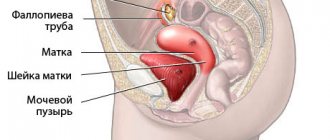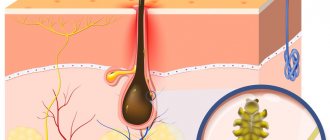- Treatment of hydrosalpinx
- Pregnancy and hydrosalpinx
- IVF for hydrosalpinx
- Prevention of hydrosalpinx
Hydrosalpinx (sactosalpinx) is the name given to transudate accumulated in the fallopian tube. The formation of transudate is not associated with inflammatory processes; it consists of secretions secreted by the fallopian tubes, extracellular fluid and blood plasma. Hydrosalpinx occurs as a result of an adhesive process in the fallopian tubes: due to a narrowing of the lumen of the tube (up to complete obstruction) and impaired blood circulation in its walls, transudate accumulates in some area.
There are simple (single closed cavity with fluid) and follicular (several cavities) hydrosalpinx. From time to time, it is possible for fluid to leak into the uterine cavity, or it can be absorbed into the walls of the tube, but the presence of adhesions contributes to the re-formation of hydrosalpinx in the same place, which causes a recurrent course of the disease.
When the cavity is filled with transudate, the walls of the pipe in this area are significantly stretched and thinned. The size of hydrosalpinx, as a rule, ranges from one to several centimeters, and it can have different, including irregular shapes.
Symptoms of hydrosalpinx
Clinical manifestations depend on how severe and how long the hydrosalpinx has existed. In some cases, symptoms may be completely absent, and pathology is detected by chance, for example, during a preventive ultrasound of the pelvic organs.
The main symptoms include pain in the lower abdomen, which is often nagging in nature. Typically, hydrosalpinx develops over a long period of time and when a sufficiently large amount of fluid accumulates, the patient complains of a feeling of heaviness in the groin area. In addition, there may be copious fluid discharge - this occurs if the hydrosalpinx empties. An increase in temperature to 38-39 degrees, throbbing pain, weakness, and in some cases tachycardia are characteristic of the acute form of the disease (against the background of acute salpingitis), when the formation of serous exudate (fluid arising at the site of inflammation) occurs in the cavity.
Symptoms of tubal obstruction
The disease in question has been asymptomatic for quite a long time, and the only thing a woman can pay attention to is the failure to become pregnant if she completely refuses contraceptives. More pronounced symptoms of tubal obstruction appear later, when the pathology is actively progressing:
- the acute form of the disease is accompanied by a sharp increase in body temperature;
- a woman is worried about weakness and a constant feeling of fatigue for no apparent reason;
- throbbing pains of a mild nature appear in the lower abdomen;
- a pronounced blush appears on the patient’s cheeks;
- palpitations and tachycardia may be present.
The main symptom of the disease in question is the lack of conception - hydrosalpinx and pregnancy are incompatible. This is easy to explain: with healthy fallopian tubes, the egg moves through them freely and is available for fertilization, and if there is fluid in the cavity of the tubes, the cilia located on the inner walls and involved in the advancement of the egg do not function, they “stick together” - pregnancy is a priori impossible.
If we talk about chronic obstruction of the fallopian tubes, it is most often diagnosed accidentally, during a regular preventive examination by a gynecologist. If a specialist has suspicions about the disease in question, the patient will be prescribed a more in-depth examination - for example, the size of the hydrosalpinx on ultrasound will be determined, the presence of inflammatory/infectious pathologies will be clarified, and the presence of benign/malignant formations will be determined.
Kinds
It is customary to distinguish several types of hydrosalpinx based on the composition of the accumulated fluid, location, severity of clinical symptoms, form of formation, as well as its morphology.
According to the composition of the liquid:
- hydrosalpinx (sactosalpinx) serous or simple;
- pyosalpinx (accumulation of pus);
- hematosalpinx (blood in the tube).
By location:
- right-sided hydrosalpinx;
- left-sided hydrosalpinx (much more common);
- double-sided
According to the form of the disease:
- spicy;
- chronic.
By form of education:
- oval;
- tubular;
- bell-shaped;
- irregular shape.
According to morphological structure:
- plain (one plain capsule);
- follicular (multiple formations with septa);
- valve (slight release of the contents of the hydrosalpinx with mucus).
Causes of hydrosalpinx
The development of hydrosalpinx (accumulation of fluid in the lumen of the fallopian tubes) is possible in women of different age categories, but most often the pathology is detected in patients during the reproductive period.
Among the causes of hydrosalpinx are:
- infectious processes;
- conditions after surgery and injury;
- endometriosis;
- development of tumor formations.
Let's look at some of them in more detail.
Infection
So, the first place in the development of hydrosalpinx is infection. Under the influence of pathogenic microorganisms, its epithelium is rejected and fibrosis develops.
The mucous membrane of the fallopian tube is represented by villous epithelium, without which it becomes impossible for the mature egg to move towards the active sperm, and therefore, conception.
Against the background of an inflammatory process caused by STI pathogens or nonspecific microflora, damage occurs to the villi of the epithelium lining the mucous membrane from the inside. Subsequently, pathological changes cover the entire thickness of the pipe. As a result, the organ becomes less elastic and deformed. In response to all these inflammatory changes, fibrin is produced. As a result, adhesions form and the patency of the pipe is impaired.
Tumors
The formation of a tumor on the fallopian tube and nearby organs can also cause a decrease in its lumen and fluid retention. Against the background of prolonged compression, circulatory disturbance occurs with subsequent degradation of the structure and the formation of adhesions inside the cavity of the pipe.
How does hydrosalpinx occur?
The accumulation of fluid normally produced by the glands of the inner surface of the fallopian tube is a consequence that occurs against the background of a primary disease. The formation of hydrosalpinx is caused by mechanical obstruction resulting from adhesions or tumor processes. In gynecology, there are four main causes leading to hydrosalpinx:
- infectious diseases of the reproductive organs;
- operations, injuries of internal organs;
- fallopian tube endometriosis;
- the presence of tumors that can mechanically block or compress the lumen of the oviducts.
It’s not for nothing that infections take first place on this list. This is the most common factor in damage to the cavities of the fallopian tubes, which subsequently leads to the loss of the epithelium, which performs a transport function, with the formation of fibrous tissue. The villous epithelium plays an important role in the process of conception. An egg cannot move independently, unlike a sperm, without having its own means for this. An already fertilized embryo is moved by special villi that line the tubes from the inside. Infectious diseases, including sexually transmitted diseases, affecting the tubes, disrupt the blood circulation of the villous epithelium. Therefore, it is important to carry out treatment on time and completely. In addition, infections affect the tissues of the tube itself, reducing their elasticity, leading to structural deformation, loss of the tube's propulsion abilities and accumulation of fluid in the blocked tube, which can have a toxic effect on the embryo. The body’s reaction to such lesions is the production of fibrin, which forms adhesions and mechanically blocks the lumens of the tube.
Injuries to the tissues and epithelium of the fallopian tube, which can be caused during medical procedures (surgeries, abortions), also lead to similar consequences. Endometriosis is also considered one of the primary diseases leading to obstruction of the fallopian tube with the formation of hydrosalpinx. In this case, the resulting foci of overgrown cells lead to mechanical blocking of the lumen.
Most rarely, hydrosalpinx is formed due to a tumor of the pelvic organs, which mechanically compresses the tube, disrupting the natural release of physiological fluid. At the point of compression, the pipe is deprived of normal blood circulation, its structure degrades, and over time, adhesions can also form inside.
Treatment of hydrosalpinx
First of all, it is necessary to identify and eliminate the cause of the development of hydrosalpinx - as a rule, it is an inflammatory process (salpingitis, salpingoophoritis, adnexitis). However, existing adhesions cannot be eliminated with medication, which means hydrosalpinx will reappear. The only method to avoid relapse is surgical intervention, during which the patency of the pipes is restored by excision of adhesions located inside and around the pipe. However, there is no guarantee that after laparoscopy the tubes will function normally: stretching of the tube walls and the formation of connective tissue has worsened their contractile activity, and the cilia located on the mucosa have lost their mobility. As a result, the mature oocyte may not reach the uterus. Thus, the patient develops infertility and the risk of ectopic pregnancy increases. The feasibility of surgical treatment is assessed by a doctor based on an analysis of the pathological process, which includes an assessment of such parameters as the severity and density of adhesions, the condition of the mucous membrane and the thickness of the wall of the fallopian tube, and the diameter of the hydrosalpinx.
Hydrosalpinx and IVF at the Family Planning Center
Carrying out IVF with hydrosalpinx may be accompanied by certain difficulties. The fluid that accumulates in the fallopian tube affected by hydrosalpinx contains microorganisms, dead cells of the mucous membrane and other elements that are toxic to the embryo. Its development can be inhibited when fluid leaks from the cavity of the fallopian tube. The normal functioning of the endometrium may also be disrupted, which negatively affects embryo implantation. With severe hydrosalpinx, the ovarian response to stimulation in preparation for IVF is usually more poor.
To increase the chances of pregnancy during IVF with hydrosalpinx, doctors recommend removing the fallopian tubes affected by hydrosalpinx. It is the removal of organs in women with hydrosalpinx that improves the prognosis, while therapy aimed at restoring their patency has a much lesser effect.
At the family planning center of Professor Tsekh, experienced specialists perform successful in vitro fertilization for patients diagnosed with hydrosalpinx after preliminary treatment of hydrosalpinx. At the same time, removal of the fallopian tubes in patients with whitening hydrosalpinx does not negatively affect the blood supply and nervous regulation of the ovaries. Preservation of the ovaries during surgical treatment of hydrosalpinx before the IVF procedure is recommended only for young women with an absolutely healthy husband.
The high percentage of births of healthy children conceived by IVF by women with hydrosalpinx speaks of the exceptional professionalism of specialists in the field of gynecology and reproductive medicine working in the clinic of Professor Tsekh. Modern technologies, along with the invaluable experience of doctors, make conception possible even with severe diagnoses, which include hydrosalpinx.
Pregnancy and hydrosalpinx
Women planning to become mothers, upon learning that they have hydrosalpinx, immediately wonder whether this pathology will affect conception.
With timely diagnosis and adequate treatment, complications and the development of infertility can usually be avoided.
How does pregnancy proceed with hydrosalpinx of one tube? This is perhaps the most common question that patients with this diagnosis ask the doctor. If the egg matures in the ovary on the healthy fallopian tube side, then there are no obstacles to fertilization. If the egg is released from the fallopian tube with hydrosalpinx, then the chances of successful conception are reduced.
The diagnosis of “hydrosalpinx” threatens not only the formation of serous fluid in the lumen of the fallopian tube, which can flow into the uterine cavity and disrupt the process of embryo implantation. If there is a mechanical obstruction in the path of the fertilized oocyte, an ectopic pregnancy may develop.
Pregnancy after removal of hydrosalpinx is possible, but only if the formation was small and the adhesive process was poorly developed.
The onset of pregnancy after surgery is affected by:
- the presence of single adhesions. In the case of follicular (multiple) adhesions, the fallopian tube is removed, and then the chances of conception are reduced;
- density of adhesions (the more elastic they are, the easier they are to remove);
- capsule size (if it is more than 2.5 centimeters, the chances of pregnancy are reduced or absent altogether);
- the condition of the mucous membrane of the fallopian tube (the more folds, the fewer fimbriae it contains);
- thickness of the wall of the fallopian tube (the thicker it is, the worse the peristalsis, which ultimately leads to a lack of mobility of the organ).
Diagnosis of hydrosalpinx
Hydrosalpinx is often discovered during a routine examination or when visiting a gynecologist regarding infertility. Only during an examination can the doctor detect a painful and round or oval-shaped formation in the area of the oviduct. It is possible to clarify the diagnosis and differentiate the dilated tube from other pathologies with instrumental examination.
Diagnosis of hydrosalpinx includes:
- gynecological examination;
- examination of vaginal discharge (smear);
- ultrasonography;
- hysterosalpingography;
- diagnostic laparoscopy.
Diagnosis of hydrosalpinx
Ultrasound scanning can be performed using both the percutaneous abdominal and vaginal methods. When examined, an enlarged fallopian tube with homogeneous contents is clearly visible between the uterus and ovary. With pyosalpinx, it has a heterogeneous character.
To check the patency of the tubes, hysterosalpingography is performed. Moreover, it should be remembered that the formation of hydrosalpinx can be a symptom of fallopian tube cancer. Therefore, when it is detected, you need to be careful and conduct additional cytology diagnostics.
Diagnosis of sactosalpinx using laparoscopy is not only a diagnostic, but also a therapeutic method. Upon examination, enlarged oviducts with thinned walls are revealed. The fimbriae are usually swollen. During laparoscopy, it is possible to dissect the adhesions surrounding the oviduct and ovaries, due to which the physiological position of the tube is changed, and create a stoma (an opening for fluid outflow) to continue conservative treatment.
IVF for hydrosalpinx
Long-term studies have proven that the presence of hydrosalpinx significantly reduces the effectiveness of infertility treatment using IVF: the likelihood of intrauterine pregnancy is reduced by almost 2 times, and the risk of miscarriage increases sharply.
Factors contributing to a decrease in the effectiveness of the IVF program:
- increased frequency of ectopic (tubal) pregnancy;
- reduction in the frequency of embryo implantation. The fluid contained in the lumen of the hydrosalpinx contains many microorganisms, lymphocytes, and other agents that have a toxic effect on embryos. Moreover, the prostaglandins, leukotrienes, and proinflammatory cytokines contained in this fluid disrupt the function of the endometrium, interfering with its ability to implant. The liquid contained in the hydrosalpinx, even when diluted to 1% solution, gives a pronounced embryotoxic effect;
- in the presence of large-sized hydrosalpinx, a mechanical effect occurs on the choroid plexuses supplying the ovaries, resulting in an inadequate response of the ovaries to stimulation of superovulation - a poor response of the ovaries;
- The normal anatomy of the fallopian tube is disrupted - its wall thickens and the mucous membrane becomes smooth. As a result, the number of receptors for progesterone and estradiol decreases, which indirectly may cause implantation problems.
In the presence of hydrosalpinx, restoring the patency of the fallopian tube through corrective surgery (salpingostomy) has a short-lived effect and can lead to relapse of the disease. Salpingectomy (removal of the fallopian tube) increases the effectiveness of the IVF program from 10 to 30-35%.
General approaches in the treatment of fallopian tubes
As follows from the list above, all pathologies of the fallopian tubes can be divided into three categories: inflammatory, blocking the lumen and oncological. A separate group should include rupture of the fallopian tubes, which sometimes occurs as a result of an ectopic pregnancy.
Inflammatory diseases are treated with conservative methods:
- antibacterial, anti-inflammatory and hormonal drugs;
- autohemotherapy;
- laser therapy, magnetic therapy, UHF therapy, ultrasound;
- medicinal electrophoresis;
- therapeutic mud baths;
- vaginal irrigation;
- gynecological massage.
Only adnexitis and salpingitis are subject to conservative therapy. Limited conservative treatment methods are applicable for MT obstruction, including adhesions. In all other situations, surgical intervention - the so-called cleaning of the fallopian tubes - remains the only treatment option.
Surgical methods of treatment
Laparotomy remains the classic method of surgical treatment for MT diseases—opening the abdominal wall to gain full access to the pelvic organs. The need for laparotomy arises in acute conditions with generalization of the process to nearby internal organs (for example, rupture of the MT with heavy internal bleeding), as well as in confirmed oncology.
In other cases, preference is given to laparoscopy - a minimally invasive technique in which all necessary surgical actions and manipulations are performed using a special device - a laparoscope - through a small incision on the abdominal wall. Using the laparoscopic method, small tumors and purulent foci are successfully removed, adhesions are eliminated and the lumen of the fallopian tubes is restored, some types of reconstructive plastic surgery are performed, and tubectomy (salpingectomy) can be performed - complete removal of the fallopian tube.
The advantage of laparoscopy is the low invasiveness of the operation, which directly affects the risk of developing postoperative complications, as well as a significant reduction in the rehabilitation period and the absence of scars.
Prevention of hydrosalpinx
To date, there are no specific methods and means to prevent pathology.
Doctors strongly recommend following certain rules and fulfilling requirements that will reduce the risk of developing hydrosalpinx:
- if any complaints appear, you should immediately visit a doctor for further examination and timely treatment of pathologies of the pelvic organs;
- regularly visit an obstetrician-gynecologist for a preventive examination;
- strictly observe the rules of personal hygiene, including during menstruation;
- avoid frequent changes of sexual partners, use barrier methods of contraception;
- to refuse from bad habits;
- treat pregnancy planning responsibly;
- Healthy food;
- to live an active lifestyle.
If a woman has bilateral hydrosalpinx, and the patency of the tubes is impaired, they must be removed. Pregnancy can be achieved using assisted reproductive technologies.
Leading specialists in the treatment of hydrosalpinx in the Southern Federal District
Ermolaeva Elvira Kadirovna is a well-known and recognized specialist in the North Caucasus in the treatment of ventral hydrosalpinx, hydrosalpinx on the right, hydrosalpinx on the left without surgery. Gynecologist, ultrasound doctor, physiotherapist-resortologist. Elvira Kadirovna is approached by women who want to improve the aesthetics of the genital organs, reduce the size of the vagina and refresh intimate relationships from all regions of Russia and foreign countries.
Ermolaev Oleg Yurievich Candidate of Medical Sciences, gynecologist-endocrinologist, operating gynecologist with 25 years of successful experience in treating ventral hydrosalpinx without surgery. Able to see relationships that elude others.
Shchepkin Petr Sergeevich Gynecologist, specialist in the treatment of hydrosalpinx on the left, hydrosalpinx on the right, ventilated hydrosalpinx. Experienced ultrasound doctor.
About the doctors of the Clinic in detail...
| INTERNATIONAL RECOGNITION of the reputation and achievements of the Women's Health Resort Clinic in the development and implementation of effective and safe treatment methods and the quality of medical services provided is the AWARDING of the Women's Health Resort Clinic in Pyatigorsk with the SIQS International QUALITY CERTIFICATE in the field of medicine and healthcare. International Socratic Committee, Oxford, UK and Swiss Institute for Quality Standards, Zurich, SWITZERLAND. |
The resort clinic for women's health operates on a paid basis and in the voluntary health insurance system.
We work WITHOUT WEEKENDS and holidays:
Monday - Friday from 8.00 to 20.00, Saturday, Sunday, holidays from 8.00 to 17.00.
Treatment of ventral hydrosalpinx, hydrosalpinx on the right, hydrosalpinx on the left in Pyatigorsk by appointment by multi-channel phone 8 (800) 500-52-74 (free call within Russia), or +7 (call from anywhere in the world).
| ONLINE about the symptoms of hydrosalpinx can be found at: [email protected] REGISTER ONLINE for the treatment of ventral hydrosalpinx WITHOUT SURGERY here. REGISTER online for treatment of ventral hydrosalpinx WITHOUT SURGERY here. Buy a course for the treatment of ventral hydrosalpinx by calling +7 (928) 022-05-32 or here. |
Sign up for hydrosalpinx treatment
We are at your FULL DISPOSAL if you have any doubts or wishes.








